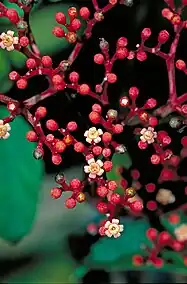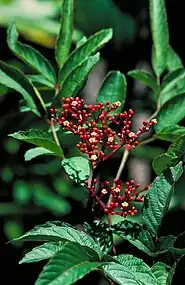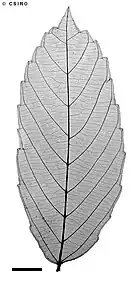| Red leea | |
|---|---|
.jpg.webp) | |
| Foliage and flower buds | |
| Scientific classification | |
| Kingdom: | Plantae |
| Clade: | Tracheophytes |
| Clade: | Angiosperms |
| Clade: | Eudicots |
| Clade: | Rosids |
| Order: | Vitales |
| Family: | Vitaceae |
| Genus: | Leea |
| Species: | L. rubra |
| Binomial name | |
| Leea rubra | |
| Synonyms[3] | |
Leea rubra, commonly known as red leea, is a plant in the family Vitaceae native to Bangladesh, Assam, Myanmar, Laos, Thailand, Cambodia, Vietnam, Malaysia, Borneo, the Philippines, New Guinea, the Northern Territory and Queensland.[3] It is a small shrub growing up to 3 m (9.8 ft) tall with 2-, 3- or 4-pinnate leaves.[4][5] The flower buds and stems are bright red, the five petals may be cream, pink or red. The fruit is a red, purple or black berry about 11 mm (0.43 in) diameter containing 4-6 seeds.[4][5]
The red leea grows in rainforest as an understory plant, at altitudes from sea level to about 400 m (1,300 ft).[4]
Conservation
This species is listed by the Queensland Department of Environment and Science as least concern.[1] As of 13 July 2023, it has not been assessed by the International Union for Conservation of Nature (IUCN).
Gallery
.jpg.webp) Inflorescence
Inflorescence Flowers and buds
Flowers and buds Foliage and flowers
Foliage and flowers X-ray of leaf
X-ray of leaf
References
- 1 2 "Species profile—Leea rubra". Queensland Department of Environment and Science. Queensland Government. 2022. Retrieved 13 July 2023.
- ↑ "Leea rubra". Australian Plant Name Index (APNI). Centre for Australian National Biodiversity Research, Australian Government. Retrieved 13 July 2023.
- 1 2 3 "Leea rubra Blume". Plants of the World Online. Royal Botanic Gardens, Kew. Retrieved 13 July 2023.
- 1 2 3 F.A.Zich; B.P.M.Hyland; T.Whiffen; R.A.Kerrigan (2020). "Leea rubra". Australian Tropical Rainforest Plants Edition 8 (RFK8). Centre for Australian National Biodiversity Research (CANBR), Australian Government. Retrieved 13 July 2023.
- 1 2 "Leea rubra". Flora Malesiana. Retrieved 13 July 2023.
External links
 Data related to Leea rubra at Wikispecies
Data related to Leea rubra at Wikispecies Media related to Leea rubra at Wikimedia Commons
Media related to Leea rubra at Wikimedia Commons- View a map of historical sightings of this species in Australia at the Australasian Virtual Herbarium
- View observations of this species on iNaturalist
- View images of this species on Flickriver